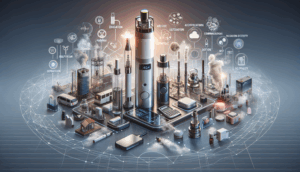Introduction:
In the fast-paced world of supply chain management (SCM) and logistics, efficiency, accuracy, and real-time visibility are crucial for maintaining a competitive edge. Over the past few years, sensors have emerged as game-changers in this domain, offering solutions that allow companies to track, monitor, and optimize the movement of goods, reduce waste, and enhance overall operational efficiency. These sensors provide data-driven insights that help streamline logistics operations, reduce costs, and ensure the timely delivery of goods.
In this article, we will explore how sensors are enhancing supply chain management and logistics, the different types of sensors being utilized, and the benefits they bring to businesses.
The Role of Sensors in Supply Chain Management
Sensors play a pivotal role in modernizing supply chain operations. They enable companies to collect real-time data on goods, shipments, equipment, and conditions, empowering businesses to make informed decisions, anticipate disruptions, and improve customer satisfaction.
Some of the key ways sensors are used in supply chain management include:
- Tracking and Visibility: Real-time tracking of shipments, inventory, and assets is one of the most significant contributions of sensor technology to supply chain management. GPS, RFID, and IoT sensors allow businesses to continuously monitor the location and status of goods in transit or storage. This level of visibility helps companies minimize delays, optimize delivery routes, and ensure timely deliveries.
- Temperature and Humidity Monitoring: For industries dealing with perishable goods or sensitive products (e.g., food, pharmaceuticals, electronics), maintaining the correct environmental conditions is essential. Temperature and humidity sensors provide real-time monitoring of storage conditions during transportation and warehousing. This ensures that products are kept within the required ranges, reducing spoilage, damage, or loss of quality.
- Inventory Management: Accurate inventory management is critical for preventing stockouts or overstocking, both of which can lead to significant operational inefficiencies. RFID sensors and barcode scanners help track inventory levels in real-time, allowing businesses to automate stock monitoring, reduce human errors, and ensure products are available when needed. This also aids in better forecasting and planning for demand.
- Predictive Maintenance: Sensors embedded in equipment, such as trucks, conveyor belts, or machinery, are used to monitor the condition and performance of assets in real-time. By analyzing sensor data, businesses can predict when maintenance is needed, preventing costly downtime and extending the life of valuable equipment. Predictive maintenance helps reduce unplanned outages, improve service reliability, and optimize repair costs.
- Supply Chain Automation: Sensor-driven automation is transforming the way businesses manage warehouse operations and logistics. Smart systems powered by sensors can autonomously handle tasks like sorting, picking, packing, and shipping products. For example, sensors integrated into automated guided vehicles (AGVs) and robots help warehouses increase throughput and accuracy while reducing labor costs and human error.
Types of Sensors Used in Supply Chain Management and Logistics
Several types of sensors are commonly used in supply chain and logistics operations. Each sensor serves a different purpose, providing valuable data that helps companies improve efficiency and reduce operational risks.
- GPS Sensors: GPS sensors are widely used in logistics to track the location of goods, vehicles, and shipments in real-time. These sensors transmit continuous location data, allowing businesses to track shipments across vast distances, monitor driver behavior, and optimize delivery routes.
- RFID and Barcode Sensors: RFID (Radio Frequency Identification) and barcode sensors are frequently used for inventory management and asset tracking. RFID sensors allow for automatic identification and tracking of products without the need for line-of-sight, offering a more efficient and faster alternative to barcode scanning.
- Temperature and Humidity Sensors: Temperature and humidity sensors are critical for industries that handle temperature-sensitive products. These sensors continuously monitor and record environmental conditions to ensure products are stored and transported at optimal temperatures. If conditions fall outside the acceptable range, the system triggers alerts, enabling proactive actions to prevent product loss.
- Accelerometer Sensors: Accelerometers are used to monitor the movement of goods and vehicles. They detect vibrations and acceleration forces, which can help identify issues such as cargo mishandling, impacts, or theft. In logistics, accelerometers help ensure that goods are transported safely, reducing the risk of damage during transit.
- Proximity Sensors: Proximity sensors are used in warehouse environments to detect the presence of objects or inventory. These sensors help manage storage space, track goods on shelves, and ensure the smooth operation of automated systems, such as conveyor belts and robotic arms.
- Weight Sensors: Weight sensors are used to monitor the weight of products or shipments at various stages of the supply chain. They help ensure proper load distribution during transportation, optimize cargo space in containers, and verify that shipments meet the correct weight specifications for regulations.
- Pressure Sensors: Pressure sensors are used to monitor the pressure levels of goods being transported in specific environments, such as liquids or gas-filled containers. These sensors help maintain the integrity of products by ensuring that pressure levels are maintained during transit and storage.
Benefits of Using Sensors in Supply Chain and Logistics
- Increased Efficiency and Productivity: Sensors enable automation, real-time tracking, and accurate data analysis, all of which contribute to increased operational efficiency. By reducing the need for manual processes, such as stock counting and shipment tracking, sensors streamline supply chain operations and allow businesses to focus on high-value tasks.
- Enhanced Accuracy and Reduced Errors: Manual data entry and tracking are prone to human errors, which can lead to costly mistakes in inventory management or shipment tracking. Sensors provide accurate, real-time data, reducing the likelihood of errors and ensuring that inventory levels, order status, and product conditions are consistently monitored.
- Improved Customer Experience: Real-time tracking, better inventory management, and accurate delivery times enhance the overall customer experience. With the help of sensors, businesses can provide accurate updates on shipment status, ensure timely deliveries, and offer better visibility into the status of goods, leading to higher customer satisfaction.
- Cost Savings: Sensors help businesses reduce costs in several ways, such as optimizing routes to save on fuel, reducing spoilage and waste of perishable goods, and lowering maintenance expenses by predicting equipment failures before they occur. By offering actionable insights, sensors enable companies to make smarter, data-driven decisions that drive cost efficiency.
- Data-Driven Decision Making: Sensors generate vast amounts of data, which can be analyzed to identify trends, optimize processes, and improve decision-making. By leveraging sensor data, businesses can make informed decisions about inventory management, transportation logistics, maintenance schedules, and other critical aspects of the supply chain.
- Enhanced Security and Theft Prevention: Sensors like accelerometers and GPS trackers enhance security by alerting businesses to abnormal movement, theft, or tampering with goods during transport. This ensures that shipments are secure and any issues are detected early, reducing losses and improving safety protocols.
Challenges of Implementing Sensor Technology in Supply Chain Management
While sensor technology offers numerous benefits, implementing it into supply chain operations is not without challenges. Some of the key hurdles businesses may face include:
- Integration with Existing Systems: Integrating sensors into existing supply chain management systems can be complex and may require substantial upfront investment in new infrastructure. Businesses must ensure compatibility with legacy systems and train employees to use new sensor-driven technologies effectively.
- Data Overload: Sensors generate massive amounts of data, which can become overwhelming without proper analysis and management. To fully leverage sensor data, businesses need to implement robust data analytics tools and processes to extract meaningful insights from the data.
- Cost of Implementation: While sensors can save money in the long run, the initial cost of purchasing, installing, and maintaining sensor systems can be a barrier for some businesses. Companies must carefully assess the return on investment (ROI) before committing to large-scale sensor adoption.
- Security and Privacy Concerns: With the increasing reliance on data collection, security and privacy concerns are top priorities. Businesses must implement strict cybersecurity measures to protect sensitive data generated by sensors from potential cyber threats.
Conclusion:
Sensors are revolutionizing supply chain management and logistics by providing real-time data, improving visibility, optimizing operations, and enhancing decision-making. From tracking shipments and monitoring environmental conditions to predictive maintenance and inventory management, sensor technology is an indispensable tool in modern supply chains. By leveraging sensors, businesses can improve efficiency, reduce costs, and deliver better service to their customers.
To explore a wide range of sensors tailored for supply chain and logistics applications, be sure to check out our shop page. If you have any questions or need assistance with selecting the right sensors for your specific needs, don’t hesitate to contact us via email. We’re here to help you optimize your supply chain with cutting-edge sensor technology.


